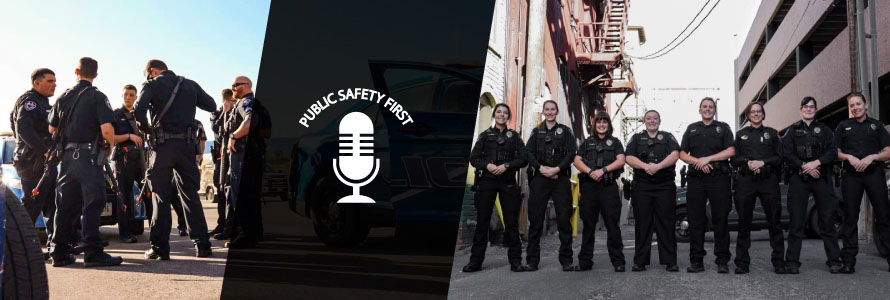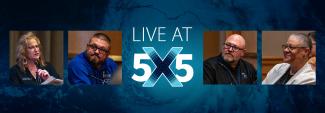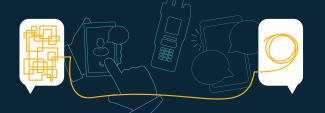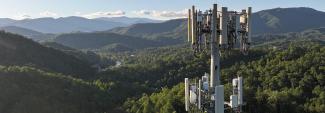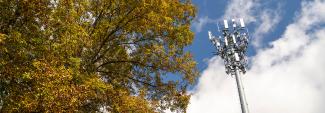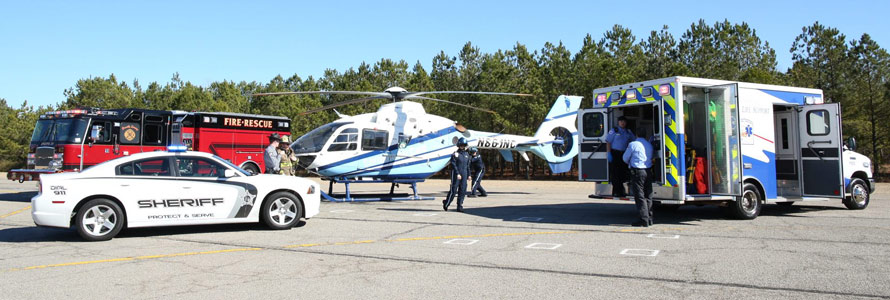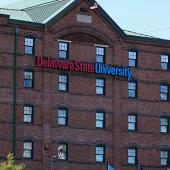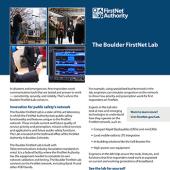Summary
The Casper Police Department in Wyoming was one of the first agencies to use the FirstNet network in August 2017 when the city’s population was expected to nearly double during a solar eclipse. Four years later, FirstNet is providing Casper police officers with coverage across the city, dedicated applications to enhance operations, and connectivity to other city agencies during everyday incidents and major emergencies.
Guest
Tracey Murdock
FirstNet Authority Senior Public Safety Advisor
Scott Hoffman
Police Technologies Manager, Casper Police Department, Wyoming
Transcript
Preview
Narrator: You're listening to Public Safety First, a podcast to help you learn about the First Responder Network Authority and how you can be part of the future of public safety technology.
And now, your host.
Tracey Murdock: Welcome to the Public Safety First podcast. I'm Tracey Murdock. I'm with the FirstNet Authority as a Senior Public Safety Advisor, and I'm proud to have with me today Scott Hoffman from the Casper Police Department. So, welcome, Scott. Thank you for joining us today.
Scott Hoffman: Thank you.
Tracey Murdock: Could you to start out and tell our public safety friends a little bit about yourself, how long you've been there? What do you do, a little bit of your background?
Narrator: You're listening to Public Safety First, a podcast to help you learn about the First Responder Network Authority and how you can be part of the future of public safety technology.
And now, your host.
Tracey Murdock: Welcome to the Public Safety First podcast. I'm Tracey Murdock. I'm with the FirstNet Authority as a Senior Public Safety Advisor, and I'm proud to have with me today Scott Hoffman from the Casper Police Department. So, welcome, Scott. Thank you for joining us today.
Scott Hoffman: Thank you.
Tracey Murdock: Could you to start out and tell our public safety friends a little bit about yourself, how long you've been there? What do you do, a little bit of your background?
Scott Hoffman: My name is Scott Hoffman. I am the Police Technologies Manager for the Casper Police Department. I started with the Casper Police Department back in 2015. Prior to that, I was with the Casper Information Technology Team from 2007 to 2014. I moved over to the Casper Police Department as their police technologies manager. And from there it's just continued to grow.
Tracey Murdock: So, how many years, then, have you been in communication technology?
Scott Hoffman: Communication technology since 2008. I have been heading up the radios and the 9-1-1 system and started implementing cellular back in 2010.
Tracey Murdock: So, you've really seen the evolution of technology going from all LMR [land mobile radio] and then as the cellular comes on and then integrating it with the department. Is that right?
Scott Hoffman: Right. We actually started with the 900-megahertz systems, with the cars. You know, throughout the city we had hotspots, but it was limited on our line of sight to those towers. So, communication was not always readily available with the computers.
Tracey Murdock: Right. So, you're in Casper, Wyoming, which is about in the center of the state of Wyoming. Could you tell us a little bit about Casper?
Scott Hoffman: People are drawn by the hunting, the fishing, and the mountains that we have. We're centrally located. So, that gives people the access to Yellowstone, Jackson, South Dakota. So, it's kind of a hub for people who are on vacation.
Tracey Murdock: So, that means that the population probably blossomed during the tourist season. What is it normally and then what kind of fluctuations do you have?
Scott Hoffman: So, we are the second largest city in Wyoming. Typically, we are 52,000 to 55,000 in population but during the summer months we can see an increase of about 10,000 people.
Tracey Murdock: So, that's quite a change. And what's the biggest hazard that you tend to prepare for?
Scott Hoffman: So, winter months are long, our typical summer is about a month and a half to, if we're lucky, two months. The rest of the time is either winter or fall. So, snow and cold, wind is our biggest public safety threats as far as weather goes.
Tracey Murdock: So, Casper Police Department has the distinction of being one of the first in the nation to operate on FirstNet. And you were one of the trailblazers looking for a way during the eclipse of 2017 to make sure that public safety had the communications that they needed when the state population just exploded. Can you tell us a little bit about that time? What were you thinking? What were you hoping for?
Scott Hoffman: So, it began back in 2015, 2016. I went to a conference and Vail, Colorado, actually used Band 14 during their World Ski Championships. After seeing the presentation and knowing the growth that we were going to have, the estimate was anywhere from 30 to 40,000 people coming into the city. We were looking at really overloading our cellular capabilities. And I was looking at ways that our officers could communicate within the vehicle. And after that presentation, I started the process of applying to the FCC to get a temporary license to bring that technology in. That process took about a year. And I eventually got a "denied" from the FCC and that was due to the RFP [request for proposals] being completed and the announcement was coming on who won that award. Our governor at the time opted into FirstNet. We were number two for opting in. And I immediately started calling around trying to figure out how do we get it here?
The main reason for looking at the Band 14 and then moving towards AT&T FirstNet was to cut down on the congestion that we were looking at having with the population growth within the city. We used another cellular company for our main and were brought in about 30 to 40 devices for the eclipse. This included our mobile command vehicle. And so, the other cellular device that we were using did have congestion. We did lose capability during that time. On the AT&T FirstNet side, we were able to keep that connection live, giving our officers that ability to communicate in the vehicles and on cellular devices.
Tracey Murdock: So, it worked. FirstNet was made for exactly that experience. How many devices did you start with? And then what's happened since then?
Scott Hoffman: So, we started with 25 cellular phones and 25 hotspots. Those hotspots were put into our fleet as our main data source. So, that would allow us that connection to our CAD [computer-aided dispatch] system, to our email, to reports, and just seeing the up-status of that device really kind of kicked it off to go live. Once we really had a foothold of what AT&T offered, we began the process of converting our entire fleet and our cellular over to FirstNet AT&T. Since then, we've really grown. We have roughly 300 devices now and are looking at adding roughly another 100 to 150 devices in the next two months. So, our growth has really taken off and our use cases have actually grown as well.
Tracey Murdock: When you say use cases, are you talking about operational things that you've actually done using the cellular?
Scott Hoffman: Yeah, so, you know, using it for different applications. We actually started parking tickets digitally and using the FirstNet devices were able to actually scan those VINs now without having to type them in, cutting that user error down a little bit. But this also allows that to integrate with that ticketing software. Within the next year, I will plan to move to the moving violations as well as misdemeanor tickets.
We are also looking at implementing push-to-talk. Push-to-talk is a nice feature to have when we want to cut down on those radio communications between teams or between individuals. It's really a two-way radio in a sense of giving that officer communication without having to make a phone call, and either that or talking to their teams. So, we are looking at moving that way as I add the new devices. One of the biggest features that we're looking at implementing is actually putting our dispatch department on the network as a backup, you know, having that capability and being able to dispatch for other departments just in case of an outage or vice versa.
Tracey Murdock: Ok, good. Are you doing anything with snow truck drivers or utility companies, garbage trucks, anything like that?
Scott Hoffman: The city IT is actually implementing the public services side of this, so they are going to be putting GPS devices on snowplows, garbage trucks, they're looking at putting it on the water trucks. This is going to give us that capability of knowing when the plows are up, down, trash collection, giving them a better route, possibly, of trash collection. So, they are working with those departments at that time. The other item that we're implementing is a GPS device, and that is going to be actually citywide. So, that's going to give our department the capability of seeing when people brake, accelerate, when they have their light bars on, off. So, we're looking at implementing that within the next few months.
Tracey Murdock: And how does that help the leaders, knowing when the light bar is on, when they brake, when they speed up? What's the impact?
Scott Hoffman: So, a lot of times when we're running code to calls, you know, there's times where we don't want to have our lights on. There are times when we do want to have our lights on. And so, avoiding accidents is our main emphasis on that. And, you know, having the officers drive safely and getting to the call on time is our priority. So, these little features are going to show us the safety of the officers while driving to a call. But it's also going to give us the wear and tear on the vehicle and help us with our training programs as we move forward.
Tracey Murdock: And I think training would be a great source to have this real life data. Does your department use drones or any type of video footage?
Scott Hoffman: We do use drones. We have in-car cameras, we have body-worn cameras, we have interview room cameras. And so, we're utilizing the AT&T's service for getting a live view from our in-car cameras. At this time, we haven't implemented the body-worn cameras with LTE, but we are moving forward with that in the next two years. Our new drone will have that LTE capability. And so, we will be utilizing that for drownings, for search and rescue, and just other incidents that may occur within the city.
Tracey Murdock: So, Scott, you have seen the network undergo quite a number of changes in the last four years. Where would you like to see the network go in the coming years?
Scott Hoffman: That's a tough question because I'm actually really happy with where we're actually at right now. Over the course of four years, we've come a long way, right? And so, I think I think FirstNet AT&T are putting the money right where it needs to be. You know, they're expanding the coverage. You know, a lot of Wyoming is very mountainous or hilly. And so, the coverage map can kind of get a little messy. And so, getting those towers put up at a faster pace is really important to us in the state as well as the county.
I think the network, as far as it goes right now, covers the city very, very well. And, you know, talking to our representatives from AT&T, you know, the amount of towers that are going up are going up rapidly throughout the state. By doing that, that's going to give us that interoperability with other agencies, with the state. And that's what we're really looking forward to, is that ability to communicate outside of LMR or just a regular phone call.
I think the most important part is we need to get more people on the network. And the more people we have on the network, the better the communication is going to be. That interoperability is, I think, the biggest factor for us moving towards FirstNet AT&T, you know, just having those agencies and the state being able to communicate back and forth, is really important to us.
Tracey Murdock: Have you had any experience with mutual aid situations that may be in the neighboring counties, regions, towns using FirstNet?
Scott Hoffman: We've had the protests and gatherings in the past year happening, and we've had other agencies come in to our jurisdiction for agency assist. We've provided them with LMRs, but we've also provided them with a cellular device to allow them to communicate back and forth with us without having any interference. So, those are the types of things we've been trying to implement quite regularly and just showing what it can do and where we're taking it.
Tracey Murdock: How do you use FirstNet Central and the Local Control portal?
Scott Hoffman: So, that's a big help to us. It's great for reports of usage to see how many people actually use the devices, how much data. You know, I use it as a cost analysis for upcoming budget years.
Tracey Murdock: Have you used the Network Status Tool?
Scott Hoffman: I have used it once just kind of seeing how it worked. So, we had that big snowstorm here, we got roughly four feet of snow. I believe Colorado had five feet over the course of two days. So, I was trying to see whether or not we were being affected by that. And it was just a test to see what it looked like.
Tracey Murdock: And it gave you visibility into the network?
Scott Hoffman: It did, yeah. So, you know, the nice thing about Casper is that we have towers on the mountain. We have towers on buildings and throughout the city. So, that coverage is pretty strong within our city limits, and I didn't see too much degradation in the city during that snowstorm.
Tracey Murdock: That's cool, I'm glad that you use that. There's a lot of capabilities and it continues to expand. OK, Scott you've been doing this for four years. There's been a lot of lessons learned. What can you share with your public safety colleagues who may be considering adopting FirstNet for the first time or maybe they're on the fence or perhaps they are thinking of expanding?
Scott Hoffman: I think it's the reliability of the network. Our previous provider, we still see outages throughout the city, and I have yet to have an outage with FirstNet AT&T. So, it's the ability to have priority of service and preemption. I mean, you may not ever use it, but to have that available is important to us.
Tracey Murdock: Have you noticed any difference having the FirstNet Authority, having that government agency overseeing the network?
Scott Hoffman: So, I think the FirstNet Authority adds value in the sense that they're always looking to better the network, whether it be a conference or a user group, you know, and looking at all the regions together to see what's important to the agencies. Having attended one of those, it was very insightful to see just how other agencies are using the network. And, you know, bringing all those people together is just a testament of their commitment to that network.
Tracey Murdock: Well, it's just been wonderful hearing your stories of four years later. Is there anything else that you want to share while we have this opportunity?
Scott Hoffman: No, it's been a fun four years, getting to know different people who are using the system and not only that, but kind of seeing where we're taking that technology. With FirstNet AT&T, capabilities are going to continue to grow as people start implementing more tools, so everything that we use in the department we can definitely use with the LTE solution, so that really helps us out.
Tracey Murdock: Scott, you were just a wealth of information. It's a pleasure speaking with you. Thank you for sharing your story with FirstNet Authority.
Scott Hoffman: Thank you. It's been a pleasure with you and FirstNet.
Narrator: Thanks for listening today. We're excited to have you join our podcast community. Make sure to subscribe on iTunes, SoundCloud, and YouTube. You can learn more about the First Responder Network Authority at FirstNet.gov and learn about FirstNet products and services at FirstNet.com.


